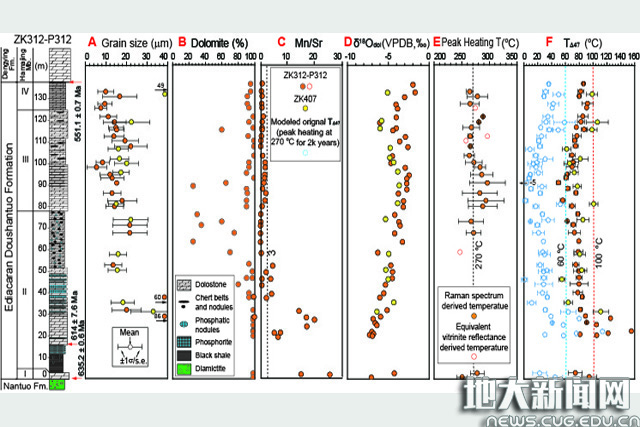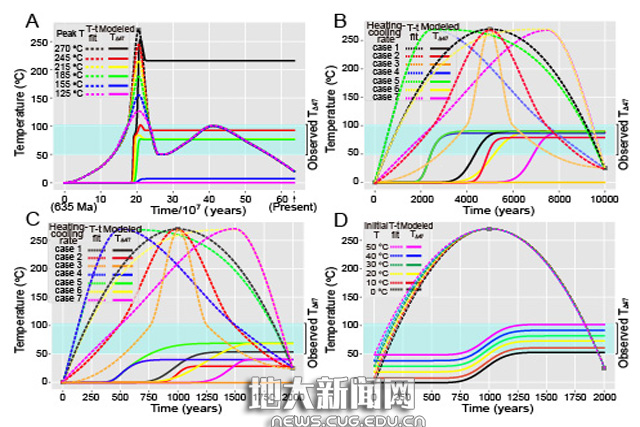The June 8th issue of Proceedings of the National Academy of Sciences of the United States of America published a paper “Massive formation of early diagenetic dolomite in the Ediacaran ocean: Constraints on the “dolomite problem”. It's an international collaborative work authored by doctoral student CHANG Biao of the State Key Laboratory of Biogeology and Environmental Geology CUG, Prof. LI Chao of the BGEG and Prof. HUANG Junhua of the State Key Laboratory of Geological Processes and Mineral Resources, CUG, Prof. XIE Shucheng and Prof. TONG Jinnan of the State Key Laboratory of Biogeology and Environmental Geology, CUG. The other contributors include researchers from the European Institute for Marine Studies, the University of California, Los Angeles, California Institute of Technology, Wuhan Institute of Geology and Mineral Resources, the University of Cincinnati, the University of California, Riverside, and Ruhr University Bochum.
Dolomite is an anhydrous carbonate mineral composed of calcium magnesium carbonate. Paleozoic and Precambrian sedimentary successions often include massive dolostone bodies that are hundreds of meters in thickness and hundreds of kilometers in lateral extent. In contrast, comparably massive dolomite successions are rare in younger marine successions, although modern seawater is oversaturated with respect to dolomite by one to two orders of magnitude. Laboratory experiments have demonstrated that the difficulty of dolomite synthesis under Earth surface conditions is likely due to hydration effects that hinder incorporation of Mg2+ into the dolomite crystal lattice. Given the kinetic barriers that inhibit low-temperature dolomite nucleation and precipitation, the existence of massive Paleozoic and Precambrian dolomite deposits has puzzled geologists for more than two centuries, giving rise to the so-called “dolomite problem”.
To resolve the dolomite problem, massive dolostones are usually attributed to slow burial or hydrothermal dolomitization of calcite or aragonite precursors by Mg-rich fluids at temperatures of >100 °C. Significantly, the widely accepted hypothesis that such massive dolomites are the product of burial-hydrothermal dolomitization challenges their validity as archives of Earth surface environments.
The researchers present a high-resolution, >63-My-long clumped-isotope temperature (TΔ47) record of shallow-marine dolomicrites from two drillcores of the Ediacaran (635 to 541 Ma) Doushantuo Formation in South China. The TΔ47 record indicates that a majority (87%) of these dolostones formed at temperatures of <100 °C (Fig. 1, F, solid circles). Because no geological process is known to reduce TΔ47 values, these results suggest that most of our dolomite samples must have formed at temperatures below 100 °C, which is inconsistent with an origin via the widely accepted burial–hydrothermal dolomitization model. When considering the regional thermal history, modeling of the influence of solid-state reordering on the TΔ47 record further suggests that solid-state reordering in the preferred 2,000-y alteration scenario would have caused an increase in TΔ47 of 42 to 55 °C (Fig. 2), which is consistent with initial TΔ47 values between 0 and 60 °C (Fig. 1, F, dotted circles), providing direct evidence of a low-temperature origin of these dolostones.
In order to explore the mechanism of low-temperature formation of the massive Doushantuo dolomites, the teams analyzed the rare earth element and δ18Ofluid compositions of their samples. Their data indicate that the massive ordered dolomites of the Ediacaran Doushantuo Formation formed in a low-temperature early-diagenetic environment with seawater-derived fluids and abundant microbial activity. These features are consistent with modern early diagenetic dolomitization models. Most likely, the sedimentary precursors of the Doushantuo dolomites (e.g., calcite, aragonite, very high-Mg calcite, or nonstoichiometric and disordered proto-dolomite) precipitated from seawater or marine porewaters and were subsequently transformed to ordered dolomites during early diagenesis in a shallow-burial porewater setting. Their findings suggest that “dolomite problem” may be a product of specific conditions common if not persistent in Paleozoic and Precambrian oceans, and that massive dolostone successions may be faithful recorders of environmental conditions in the early oceans. Thus, primary limestones (CaCO3) are valid archives of Earth surface environments.
In summary, the clumped-isotope temperature, elemental, isotopic, and petrological evidence suggests that the mechanism of low-temperature formation of the massive modern dolomites can explain massive early-diagenetic dolomite formation in oceans. Their findings not only shed new light on the “dolomite problem” but also provide the theoretical foundation for dolostones as faithful recorders of environmental conditions in the early oceans.

Fig.1 Clumped-isotope–based paleotemperature (TΔ47) profile (F) of the Ediacaran Doushantuo Formation dolomites, with paired petrological and geochemical data for evaluation of dolomitic recrystallization, diagenesis, and solid-state reordering, from drillcores ZK407 and ZK312-P312 in Zhangcunping area, Hubei Province, South China (A-E). The low TΔ47 values in our drillcores indicate better preservation of original TΔ47 signatures in the Zhangchunping area.

Fig.2 Solid-state reordering modeling of the study Doushantuo Formation.
Paper Information
Title: Massiveformation of early diagenetic dolomite in the Ediacaran ocean: Constraints onthe “dolomite problem”
Authors: Biao Chang, Chao Li*, Deng Liu, Ian Foster, Aradhna Tripati, Max K.Lloyd, Ingrid Maradiaga, Genming Luo, Zhihui An, Zhenbing She, Shucheng Xie,Jinnan Tong, Junhua Huang*, Thomas J. Algeo, Timothy W. Lyons, and AdrianImmenhause
DOI: 10.1073/pnas.1916673117
Published: June 8, 2020
Full Text: https://doi.org/10.1073/pnas.1916673117